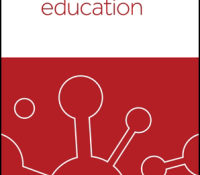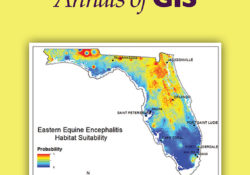tandfonline.com har udgivet en rapport under søgningen “Teacher Education Mathematics”: ABSTRACT Formulae display:?Mathematical formulae have been encoded as MathML and are displayed in this HTML version using MathJax in order to improve their display. Uncheck the box to turn MathJax off. This feature requires Javascript. Click on a formula to zoom. ABSTRACT Standardized test scores are often used to measure students’ academic success. Although factors that affect student success involve teaching techniques, classroom dynamics, and study skills, there are other factors outside the classroom that could influence students’ overall academic performance. Oftentimes, these factors are overlooked or easily deemed uncontrollable by educators. Prior studies have identified and examined such factors; however, for this analysis, we will use Geographic Information Systems (GIS) to analyse and display spatial patterns of these external… Continue Reading →
Like this:
Like Loading...
eric.ed.gov har udgivet: This report on the SCALE Institutions of Higher Education (IHE) Case Studies line of work provides preliminary findings about SCALE activities at the University of Wisconsin-Madison (UW-Madison). This study focuses on the structural and behavioral dynamics influencing the implementation of the four core SCALE strategies for effecting change in IHEs: (1) reform undergraduate science, technology, engineering and mathematics (STEM) courses; (2) promote collaboration between STEM and education departments regarding pre-service teacher education; (3) promote collaboration between IHEs and K-12 districts regarding in-service professional development; and (4) improve institutional policies and practices at the IHE level that support faculty engaged in pre- and in-service activities. Preliminary findings indicate that SCALE is making progress in each of these areas. Through the Math Masters and Immersion Unit professional development programs… Continue Reading →
Like this:
Like Loading...
eric.ed.gov har udgivet: The number of jobs in science, technology, engineering, and math (STEM) is growing rapidly and is expected to increase by approximately 1 million in the United States between 2012 and 2022 (Vilorio, 2014). People of many racial/ethnic minorities, however, including Hispanic people, are underrepresented among recipients of STEM degrees and among employees in STEM fields (Beede et al., 2011). Regional Educational Laboratory Southwest conducted this review of the research literature to identify malleable factors that can be measured in K-12 settings and that predict students’ postsecondary STEM success (defined as enrolling in, persisting in, and completing a postsecondary STEM major or degree), particularly for Hispanic students. Identifying these predictive malleable factors can help policymakers and district and school administrators develop and implement interventions that increase the percentage… Continue Reading →
Like this:
Like Loading...

tandfonline.com har udgivet en rapport under søgningen “Teacher Education Mathematics”: Abstract Abstract This study aimed to investigate the impact of a flipped classroom on the self-regulated learning (SRL) and academic achievement of seventh-grade junior high school students. A quantitative approach was used to compare the traditional and flipped classroom approaches. The data were obtained using the Motivated Strategies for Learning Questionnaire (MSLQ) along with students achievement scores. Cognitive learning strategies and metacognitive self-regulation strategies were investigated as indicators of students SRL strategies. The results indicated that 64 seventh-grade participants demonstrated a good-to-high level of practicing SRL within the flipped classroom environment. Moreover, the student participants appeared to self-regulate their metacognitive learning strategies in the flipped classroom environment more than those in the traditional learning environment. In terms of their academic… Continue Reading →
Like this:
Like Loading...
eric.ed.gov har udgivet: In a decade, virtual education in its contemporary form of asynchronous, computer-mediated interaction between a teacher and students over the Internet has grown from a novelty to an established mode of education that may provide all or part of formal schooling for nearly one in every 50 students in the US. In a non-random 2007 survey of school districts, as many as three out of every four public K-12 school districts responding reported offering full or partial online courses. There can be little question that virtual courses in certain areas (e.g., math, English, social studies) produce tested achievement results on a par with those of their conventionally taught counterparts. Nor is it debatable that more complex areas of the curriculum (e.g., the arts) are beyond the reach… Continue Reading →
Like this:
Like Loading...
eric.ed.gov har udgivet: The Louisiana mathematics standards were created by over one hundred Louisiana educators with input by thousands of parents and teachers from across the state. Educators envisioned what mathematically proficient students should know and be able to do to compete in society and focused their efforts on creating standards that would allow them to do so. The new standards provide appropriate content for all grades or courses, maintain high expectations, and create a logical connection of content across and within grades. The K-12 mathematics standards lay the foundation that allows students to become mathematically proficient by focusing on conceptual understanding, procedural skill and fluency, and application. This report presents the Math Standards in Louisiana for Kindergarten through Eighth Grade for Algebra I, Geometry, and Algebra II. Link til… Continue Reading →
Like this:
Like Loading...
eric.ed.gov har udgivet: The purpose of this hearing was to review the effectiveness and value of the National Science Foundation’s (NSF’s) past and present programs in support of improvement of K-12 science and math education and to examine what role the Foundation should play in future federal initiatives for strengthening K-12 science and math education. This hearing follows up on the March 30 Science Committee hearing entitled, “K-12 Science and Math Education Across the Federal Agencies,” which featured Secretary of Education Margaret Spellings, NSF Director Arden Bement, and representatives from the National Aeronautics and Space Administration, the National Oceanographic and Atmospheric Administration, and the Department of Energy. The officials outlined their individual agencies’ activities to improve K-12 science and math education and described interagency coordination efforts. The charter for that… Continue Reading →
Like this:
Like Loading...
eric.ed.gov har udgivet: This groundbreaking study finds that nearly all parents seek schools with a solid core curriculum in reading and math, an emphasis on science, technology, engineering, and math (STEM) education, and the development in students of good study habits, strong critical thinking skills, and excellent verbal and written communication skills. But some parents also prefer specializations and emphases that are only possible in a system of school choice. “Pragmatists” (36 percent of K-12 parents) assign high value to schools that, “offer vocational classes or job-related programs.” Compared to the total parent population, Pragmatists have lower household incomes, are less likely themselves to have graduated from college, and are more likely to be parents of boys. “Jeffersonians” (24 percent) prefer a school that “emphasizes instruction in citizenship, democracy, and… Continue Reading →
Like this:
Like Loading...
eric.ed.gov har udgivet: As students in elementary schools through Secondary Schools (K-12) have difficulty Learning Science, Technology, Engineering, and Math (STEM) discipline, their numbers enrolling in these disciplines in higher education are also decreasing. So Researchers are looking for news styles in education including the use of Internet and Communication tools (ICT) to motivate students and enhance learning. Blogs are one of the ICT tools that could be used along with the use of Project Based Learning (PBL) in STEM discipline for that matter. But there are certain aspects that need to be explored for a successful blending of class blogs along with PBL in a STEM discipline in order to give students more engagement and motivation. Link til kilde
Like this:
Like Loading...
tandfonline.com har udgivet en rapport under søgningen “Teacher Education Mathematics”: Abstract Abstract In this overview piece, we document the six student perception surveys (SPSs) currently available for state, district, and school consumption and use, given SPSs are increasingly becoming one of the more popular “multiple measures” being used to evaluate teacher qualities. We present descriptive information about each of these SPSs, including information related to cost(s), constructs or domains assessed, number of items, response option types, grade level(s) in which the SPS can be administered, etc. Given this information, we also present implications for practice, as well as calls for future research into each SPS individually and writ large, given SPSs’ increasing popularity post the passage of the Every Student Succeeds Act (ESSA), and also given what consumers might need… Continue Reading →
Like this:
Like Loading...


